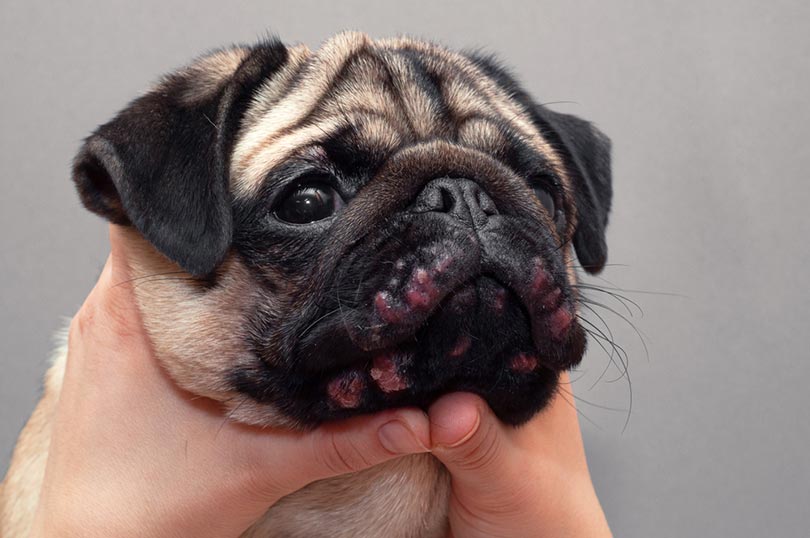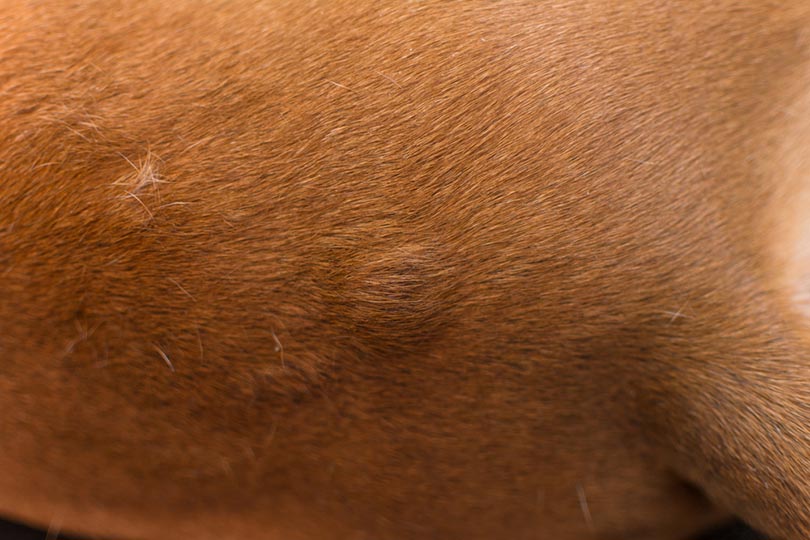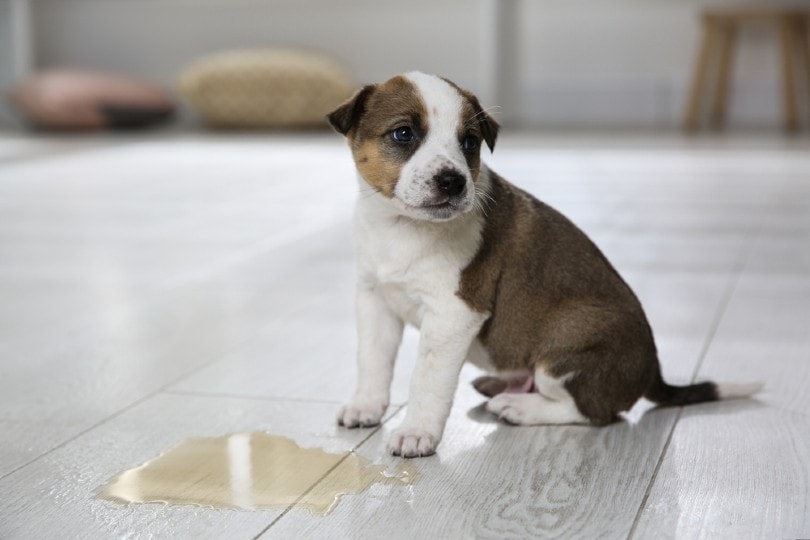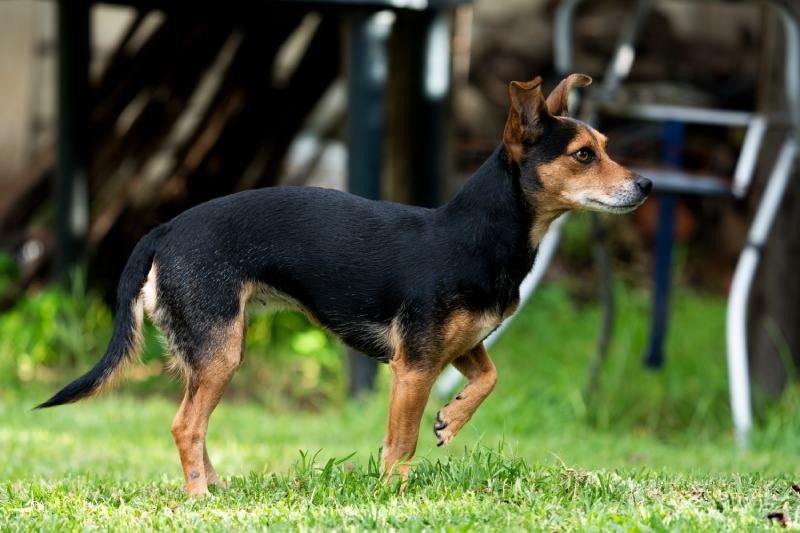Allergy Bumps on Dogs: Urticaria & Hives Explained (Vet Answer)
Updated on

Click to Skip Ahead
Bumps on your dog’s skin can be challenging and, more so, concerning. What caused the bump? Will it hurt my dog? How concerned should I be?
One of the more common bumps encountered in our canine companions is urticaria, which is the medical term for hives. Hives are basically a swelling in the skin resulting from an immune reaction to a foreign substance and the body’s attempt to prevent that foreign substance from causing damage.
Unfortunately, with hives, sometimes this immune reaction is caused by substances that aren’t actually harmful, and the reaction is a bit of overkill to what would otherwise be a harmless situation. A major downside of hives is that, on the more severe end of the spectrum, the reaction can become life-threatening and quite quickly.
Read on to learn more about urticaria and hives in dogs, what these allergy bumps might be telling you, and what to do about them!
Urticaria and Hives in Dogs Explained – What Are They?
Urticaria is the medical term for hives, which are raised skin welts (or bumps). They are caused by a reaction of various immune cells that live within the skin, surveilling for any foreign invaders that might lead to potential bodily harm. Hives represent a reaction by these cells, which is swelling and inflammation of the associated skin.
Hives are often very itchy and can sometimes become quite red due to inflammation. They can develop almost anywhere on the skin but are more common on the back, neck, muzzle, face, and legs. Hives can appear (and disappear) quickly.
In mild cases, hives may not require treatment, just close monitoring at home. However, severe cases may progress to a condition called anaphylaxis—in which the entire body becomes involved in the allergic reaction, and anaphylactic shock (and death) can occur. In such severe cases, emergency treatment is needed.

What Are the Causes of Urticaria and Hives in Dogs?
1. Vaccines
Some dog vaccines can lead to allergic reactions that present as hives. This can happen almost immediately after a vaccine or a delay may occur. If you notice this happening after your dog receives a vaccine, alert your vet immediately. This may require treatment, and your vet will also want to know if this happened in order to make decisions about how to best vaccinate your dog in the future.
2. Shampoos
Some topical products, including shampoos, can sometimes set off an allergic reaction in the skin, leading to hives.
3. Medications
Similar to vaccines, allergic reactions can occur after dogs receive some medications. Just like vaccines, it is important to alert your vet as soon as you notice this because the medication may no longer be suitable for your dog.
4. Insect Bites and Stings
Insect bites and stings from bees, wasps, hornets, fleas, spiders, chiggers, and other bugs can all potentially lead to hives in dogs. Some dogs may only get a few hives, while others may have the same bite or sting and develop many hives as a result. It can, therefore, vary widely depending on the particular dog. Hives from insect bites and stings are most commonly found around the face and muzzle of a dog.
Where Are the Signs of Urticaria and Hives in Dogs?
Signs of urticaria and hives in dogs can vary widely. Often, individual dogs will have very different responses, depending on their immune systems and genetics.
- Skin redness
- Raised skin welts (hives)
- Facial swelling, including eyes and muzzle
- Vomiting or diarrhea
- Drooling
- Lethargy or acting dull
- Hiding or other changes in behavior
- Fever
- Difficulty in breathing
- Difficulty eating
- Itching
What Are the Potential Dangers of Urticaria and Hives in Dogs?
The danger of any allergic reaction, such as urticaria or hives, is that if the immune system cannot stop it, it can progress to anaphylactic shock.
Anaphylactic shock is a condition in which the entire body becomes involved in an overexuberant immune response, and as a result, various organ systems, such as the kidneys, lungs, and others, start to shut down. If not treated immediately, this can result in death.
Even mild cases of hives, once triggered by a certain substance, will likely recur with repeated exposure to that substance. Often, each time exposure occurs, the reaction will get worse.

Frequently Asked Questions (FAQ)
Are hives contagious?
No, the condition itself is not contagious. However, the same inciting cause may lead to hives in other exposed dogs.
How are urticaria and hives diagnosed?
Generally, a clinical history and a physical exam are sufficient to diagnose the condition.
What are the treatment options for urticaria and hives in dogs?
It depends on how severe the hives are. Sometimes, no treatment is required. In more severe cases, sometimes an anti-inflammatory medication will be given or prescribed. In very severe cases, including anaphylactic shock, sometimes IV fluids, along with anti-inflammatory medications, must be used to stabilize the dog. This will often require hospitalization and close veterinary monitoring for the duration of treatment.
Conclusion
Urticaria and hives can sound straightforward in dogs, but in reality, they can quickly become complicated and life-threatening conditions. Don’t hesitate to let your vet know if you see hives in your dog, and make sure to note what your dog was doing, eating, or exposed to at the time. This will help to narrow down what may have caused the reaction.
Many dogs with hives will not require treatment. However, if you see any changes in your pet’s breathing, if the hives or swelling becomes widespread, or if your pup simply seems too uncomfortable, never hesitate to reach out and get the help they need.
Related Reads:
- Dog Allergy Testing: Types of Tests, Reliability & How It Works
- Why Are There Lumps and Bumps On My Dog’s Skin? (Vet Answer)
Featured Image Credit: Yekatseryna Netuk, Shutterstock














